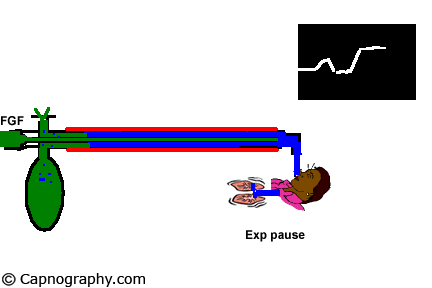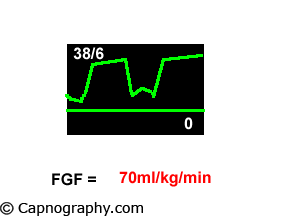Bain breathing system
M Ravi Shankar MD
Professor and Chair of Anesthesia,
JIPMER, Pondicherry, India
Brigham and Women’s Hospital, Harvard Medical School
Functional analysis

Effect of FGF on capnogram

Spontaneous ventilation: 1.5 – 2 times the patient’s minute ventilation. Pattern of ventilation during spontaneous ventilation can not be controlled by the anesthesiologist.
Spontaneous respiration: The breathing system should be filled with FG before connecting to the patient. When the patient takes an inspiration, the FG from the machine, the reservoir bag and the corrugated tube flow to the patient. During expiration, there is a continuous FGF into the system at the patient end. The expired gas gets continuously mixed with the FG as it flows back into the corrugated tube and the reservoir bag. Once the system is full the excess gas is vented to the atmosphere through the valve situated at the end of the corrugated tube near the reservoir bag. During the expiratory pause the FG continues to flow and fill the proximal portion of the corrugated tube while the mixed gas is vented through the valve. During the next inspiration, the patient breaths FG as well as the mixed gas from the corrugated tube. Many factors influence the composition of the inspired mixture. They are FGF, respiratory rate, expiratory pause, tidal volume and co2 production in the body. Factors other than FGF cannot be manipulated in a spontaneously breathing patient. It has been mathematically calculated and clinically proved1,2 that the FGF should be atleast 1.5 to 2 times the patient’s minute ventilation in order to minimise rebreathing to acceptable levels.
Controlled ventilation: To facilitate intermittent positive pressure ventilation, the expiratory valve has to be partly closed so that it opens only after sufficient pressure has developed in the system. When the system is filled with fresh gas, the patient gets ventilated with the FGF from the machine, the corrugated tube and the reservoir bag. During expiration, the expired gas continuously gets mixed with the fresh gas that is flowing into the system at the patient end. During the expiratory pause the FG continues to enter the system and pushes the mixed gas towards the reservoir. When the next inspiration is initiated, the patient gets ventilated with the gas in the corrugated tube i.e., a mixture of FG, alveolar gas and dead space gas. As the pressure in the system increases, the expiratory valve opens and the contents of the reservoir bag are discharged into the atmosphere.
Factors that influence the composition of gas mixture in the corrugated tube with which the patient gets ventilated are the same as for spontaneous respiration namely FGF, respiratory rate, tidal volume and pattern of ventilation. The only difference is that these parameters can be totally controlled by the anaesthesiologist and do not depend on the patient. Using a low respiratory rate with a long expiratory pause and a high tidal volume, most of the FG could be utilized for alveolar ventilation without wastage.
Analyzing the performance of these systems during controlled ventilation, two relationships have become evident. 1) When FGF is very high the Paco2 becomes ventilation dependent (as during spontaneous respiration). 2) When the minute volume exceeds the FGF substantially, the Paco2 is dependent on the FGF3. Combining these influences a graph can be constructed as shown in Fig.13. An infinite number of combinations of FGF and minute ventilation can be chosen to achieve a desired Paco2. One can use a high FGF and a normal minute volume of 70 ml/kg to achieve a normal Paco2 of 40 mm Hg. This is uneconomical and leads to low humidity and heat loss. Alternately, a FGF equivalent to the predicted minute volume i.e., 70 ml/kg can be chosen and the patient ventilated with at least twice the predicted minute volume i.e. 140 ml/kg. Here a deliberate controlled rebreathing is allowed in order to maintain normal Paco2 along with high humidity, less heat loss and greater economy of fresh gas. Combinations between these two extremes can also be used. It is important to remember that using a low FGF with normal minute ventilation, can lead to hypercarbia; a moderate FGF and hyperventilation, can lead to hypocarbia
1. Mapleson WW. The elimination of rebreathing in various semiclosed anaesthetic systems. British journal of Anaesthesia; 1954;26: 323-32.
2. Ward CS. In: Anaesthetic equipment. Physical principles and maintenance; W.B.Saunders, London; 2nd ed. 1985.
3. Rose DK, Froese AB. The regulation of Paco2 during controlled ventilation of children with a T-piece. Canadian Anaesthetists Society Journal 1979; 26: 104-13.

 Twitter
Twitter Youtube
Youtube










